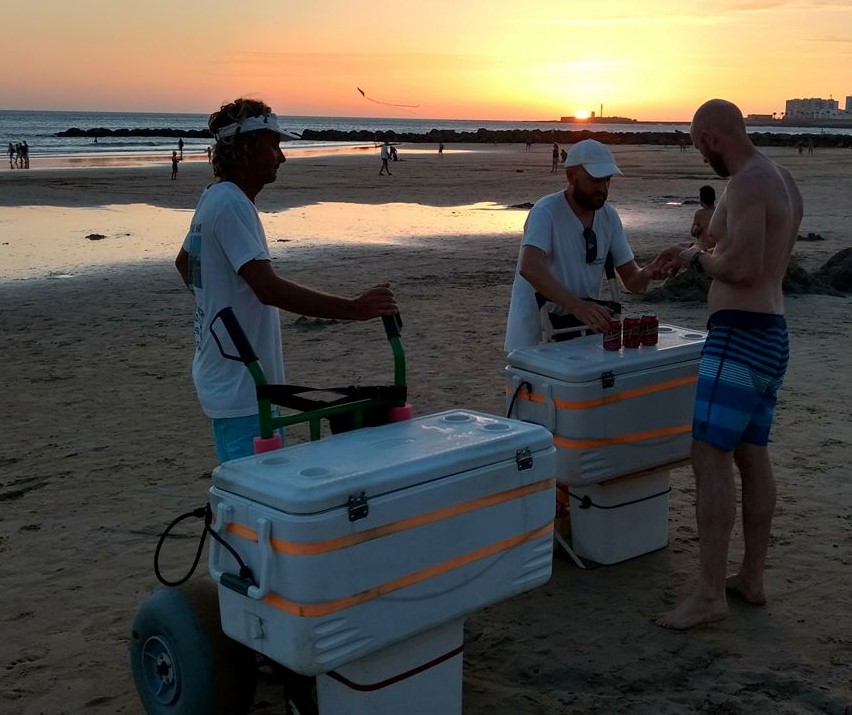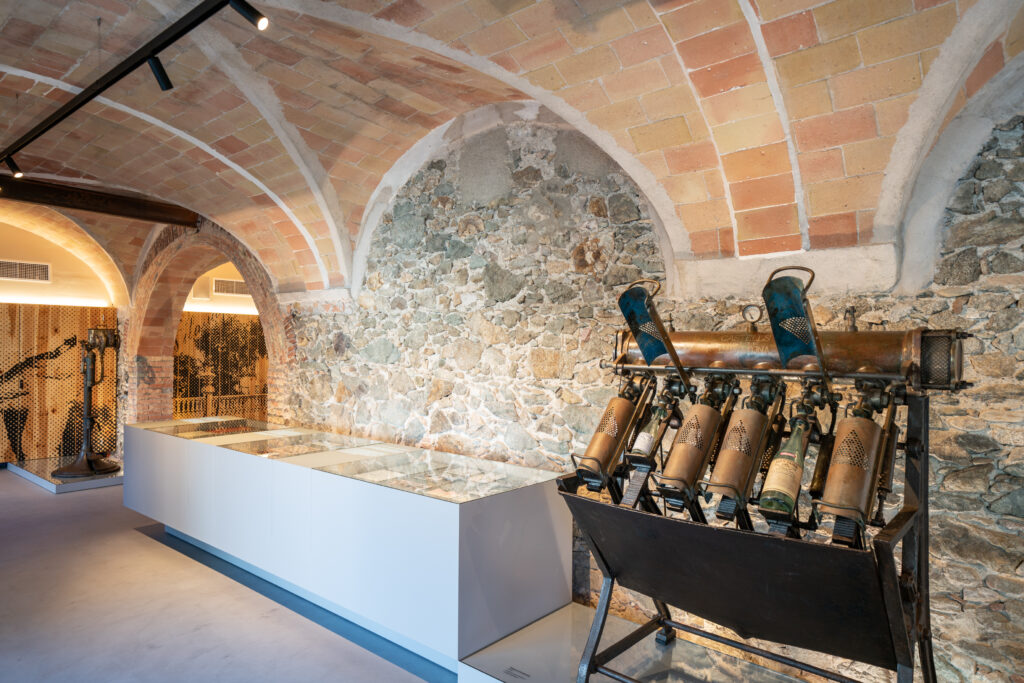My plan for the summer is a simple one. I will work during the day, look after the kids, keep house, walk the dogs. Then, when the heat has subsided, I head down to the beach in the evening with a deckchair, a good book, my goggles and a sandwich. There are almost always friends there and we hang out, go for a swim, drink cold beer. The local lager is Cruzcampo, brewed in Seville by a subsidiary of Guinness. It’s not the greatest beer in the world. And yet, after a swim on Santa María beach, in the company of friends, an hour before sunset, it’s unbeatable.
Three or four different sellers tramp up and down the shoreline, dragging trolleys stacked with huge coolers and cardboard boxes full of bags of crisps and packets of sunflower seeds. We are loyal customers of our Argentinian providers, Micki and Andrés.

The suspension of the English football season during lockdown means that the remaining fixtures are being played in July. One of my beach friends supports Leeds United, who, after a 16-year absence, are hoping to make it back into the top flight under their Argentine manager, Marcelo Bielsa. The beer sellers have adopted Leeds as their team and I decide to jump onto the bandwagon, out of friendship and also on the flimsy basis that the great Leeds team of the 1970s, which I am just old enough to remember, was built around a core of Scottish players and captained by Billy Bremner, who comes from my home town of Stirling.
It’s been a long few months, a hard year, but each evening, as I submerge my head beneath the surface of the still-cool water, I feel the tensions and anxieties slip away. They will return, I know, but the knowledge that, every evening without fail I can slough them off, makes them an easier burden to carry.
I’m quite happy with my workload; it will allow me to recoup some of the earnings I lost during lockdown but still means I can have a fairly relaxed summer. My biggest project this month is some TV development work. This consists of the full script for the first episode of a new series, along with a dossier: plot outlines, production notes, character sketches. I can’t go into details about the text itself as the project is under wraps but I can describe the trail that led to me getting the assignment.
For this job, I was approached by a Spanish TV production company who are developing the proposal to pitch to the likes of Amazon and Netflix (both of whom are keen to up their share of locally produced content). My client got my details from their legal counsel. Who heard about me from another TV production company I worked for last year (on a football-themed period drama, also under wraps…). They, in turn, heard about me from a literary agency for whom I regularly translate samples and marketing material. The literary agency heard about me from a Spanish publisher to whom I’d sent a sample translation of a novel I was interested in pitching. There was an old woman who swallowed a fly…
In other words, the trail starts with a failure: an unpaid sample of a novel I have never pitched, a Spanish publisher I have never worked for. But this initial failure has led to a series of interesting projects and regular clients. There was some luck involved, no doubt; some persistence; some people skills. But also, I hope, some good solid work, coupled with a growing reputation for versatility and reliability.
Just when everything seems to be going well, I get some nasty news. The lease on our flat is up for renewal in October and I contact the landlady to ask her to do the new contract in my name as my ex is no longer resident. A few days later I hear back from the landlady. She won’t be renewing the lease as to do so would entitle me to a five-year contract and she’s planning to sell the flat in the near future. This is a blow. It also puts a little perspective on the popular notion that literary translators are driven by a passion for the art or are engaged in a form of political activism. Those things are all good, but I work mainly to commission, to put food on the table and pay the rent.
The beach, the swimming, a steady supply of cold Cruzcampo and a tight deadline for the TV script help to keep me sane but the thought of trying to find another flat, large enough for me and the kids, dog-friendly, then organize a move, is just too much. Fortunately, after much pleading, the landlady agrees to draw up a short-term lease for me. It’s a huge relief. I’m very aware that my tank is empty. A year of separation and several months of pandemic have depleted my reserves. I’m sometimes surprised at how well I’m doing – but I’m also aware that I am never far from the possibility of breakdown.
My other major project this month is not, even by my generous definition, literary but it’s every bit as creative and challenging as anything else I’ve worked on so far this year. It is a video script for a visitor centre at a mineral water production plant, a site which also incorporates an exhibition, a small conference facility and the original wells, dating back to the early 20th century. It’s a mix, then, of local history, architecture, food technology and corporate communications. So much for specialization!

This, I think, is where theories of translation fall down. I’m drawing on my previous experience with this client, my knowledge not just of their business activity but of their corporate culture. I have to do a lot of research. I have to request photos from the client (unfortunately there’s no chance of an all-expenses paid trip to the centre itself). And I have to imagine the end users of the text and adjust my translation accordingly.
Here are a few examples:
Durante la postguerra, a consecuencia de las interrupciones en el subministro eléctrico se ralentizó la producción, pero a partir de los años setenta del siglo XX aumentó la plantilla y se instalaron máquinas automáticas para limpiar, rellenar, tapar y encajar.
DeepL machine translation renders this as:
During the post-war period, as a result of interruptions in the electricity supply, production slowed down, but from the 1970s onwards the number of staff increased and automatic machines were installed for cleaning, filling, covering and fitting.
And here’s my culturally adapted version, which unpacks the reference to the post-war period:
During the lean years of the 1940s and early 1950s, following the end of the Spanish Civil War, production was often interrupted by an unreliable electricity supply. By the 1970s, though, the company was in good health, taking on more workers and installing automatic machines to clean, fill, seal and pack the bottles.
In the following section, the original authors were keen to emphasize the brand’s longstanding connection to Salvador Dalí:
Además, cabe añadir que el agua de Vilajuïga mantiene una estrecha vinculación con Salvador Dalí. En estas fotografías de 1955 se puede ver a Ramón Margineda con Salvador Dalí, quien sabemos consumidor habitual del Agua de Vilajuïga
Here’s the machine translation version:
It should also be added that Vilajuïga water has close links with Salvador Dalí. In these photographs from 1955 we can see Ramón Margineda with Salvador Dalí, who we know is a regular consumer of Aigua de Vilajuïga.
I have to admit that the original Spanish struck me as a little clunky and I took the opportunity to improve on it:
The waters of Vilajuïga also had an illustrious fan. These photographs, taken in 1955, show Ramón Margineda with Salvador Dalí, who drank Agua de Vilajuïga on a regular basis.
Finally, a couple of more technical sections:
Es un agua de mineralización media. Esto le aporta un sabor mineral profundo, y al mismo tiempo, hace que sea ligera y fresca. Como agua rica en bicarbonatos, Vilajuïga deja en boca una sensación alcalina acompañada por un toque acídulo aportado por el gas natural.
Again, the machine translated version:
It is a medium mineralised water. This gives it a deep mineral taste, and at the same time, makes it light and fresh. As a water rich in bicarbonates, Vilajuïga leaves an alkaline sensation in the mouth accompanied by an acidic touch provided by natural gas.
And my own rendering:
Vilajuïga is moderately mineralized, giving it a distinct mineral flavour while remaining light and fresh. Rich in bicarbonates, it offers an alkaline sensation balanced by the slight acidity of the natural gas.
And finally:
Las salas limpias están especialmente diseñadas para obtener bajos niveles de contaminación y han de tener ciertos parámetros ambientales estrictamente controlados, como por ejemplo la presión, que es diferente de la exterior para evitar que entren partículas del ambiente.
Machine translation:
Clean rooms are specially designed to obtain low levels of contamination and must have certain strictly controlled environmental parameters, such as pressure, which is different from that outside to prevent particles from entering the environment.
And my version (drawing on my knowledge of cleanroom technology, garnered from years of doing translating corporate communications texts for a pharmaceuticals company…):
Cleanrooms are specially designed to ensure low levels of contamination, and must satisfy strict environmental parameters, such as having differential air pressure to prevent particles flowing in from outside.
As an aside, I hope it’s clear that, although the machine translation isn’t awful, it doesn’t offer you a route (let alone a shortcut) to my finished version. Once you set off down that hyper-literal track, there’s no way back.
I’m glad that the budget for this job includes a separate revision stage – and lucky to have a colleague who is perfect for the role of editor. One of my regular revision partners, Simon Berrill, is an all-rounder, but his specialist areas include wine and culture. Just as importantly for this job, he’s based in Catalonia. We’ve been revising each other’s work for three years now and are familiar with our respective strengths and weaknesses, our individual preferences and styles. I ask Simon to change anything that he thinks can be improved, and what I get back is extremely helpful, ranging from typical editorial tweaks for clarity and constancy, all the way through to sensitive cultural adaptation. Translation can be a lonely business at times – it’s easy to lose sight of the collaboration between author/client and translator that necessarily underpins our work. But, as we emerge (for now) from lockdown, the opportunity to work closely with a friend feels particularly valuable.